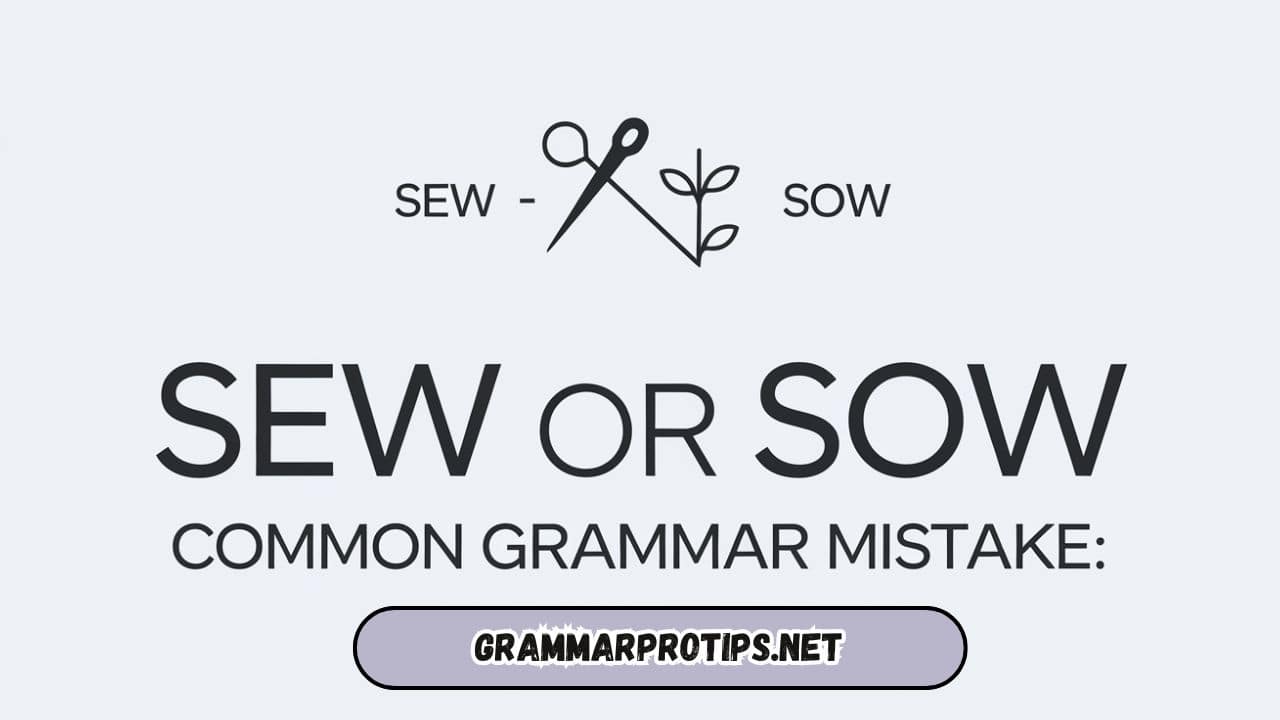The English language is full of tricky word pairs that often trip people up, even those who speak the language fluently. One such pair is sew and sow.
These two words might look similar, and they even sound the same in many cases, but they carry different meanings. Getting them mixed up can make your writing or speech sound awkward or incorrect.
But don’t worry! In this comprehensive article, we will explore everything you need to know about these words, how to use them properly, and how to avoid common mistakes.
By the end, you’ll have a clear understanding of sew and sow and how to use them confidently in various situations. Let’s dive into the details!
Sew or Sow – What’s the Difference?
At first glance, sew and sow may appear almost identical.
They share a similar pronunciation, and they only differ by a single letter. However, each word has a distinct definition, and they’re used in different contexts.
Understanding these distinctions is essential for mastering their use in your writing and speech.
Sew – What Does It Mean?
The verb sew refers to the act of stitching fabric together using a needle and thread (or sometimes a sewing machine).
It’s primarily a literal action and is typically associated with tasks like mending clothes, making quilts, or creating craft projects.
When you’re sewing something, you’re physically joining pieces of material.
Examples of Sew in Sentences:
- I need to sew a button onto my jacket.
- She spent hours sewing a quilt for her grandmother.
- I’ll need to sew a patch onto my jeans because they’ve torn.
In each of these examples, the action involves fabric and thread, making sew the correct word to use.
Sow – What Does It Mean?
On the other hand, sow primarily refers to planting seeds in soil to grow plants, vegetables, or flowers.
While its literal meaning involves agriculture, sow is also frequently used in metaphorical contexts to describe the act of initiating or spreading abstract ideas or emotions.
Examples of Sow in Sentences:
- In spring, I plan to sow seeds in my garden.
- By sowing kindness, we can create a more positive community.
- His actions are sowing doubt about the future of the project.
In these examples, sow refers either to the physical act of planting or to a metaphorical action of spreading something intangible.
How to Tell the Difference Between Sew and Sow
One of the primary reasons for the confusion between sew and sow is their similar pronunciation. Both words sound like “so,” but their meanings are entirely different.
So, how do you remember which one to use?
Here’s a simple trick:
- Sew is related to fabric and stitching. If it involves needle and thread, it’s sew. Think about the motion of stitching fabric together.
- Sow is about seeds and planting. If it involves gardening, growing, or spreading ideas or change, it’s sow. Imagine yourself in a garden, planting seeds.
This trick should help you easily differentiate between the two in most cases.
Common Mistakes with Sew and Sow
While the rules for using sew and sow are relatively straightforward, many people still make mistakes, especially in spoken language where the words sound alike.
Let’s explore some common errors and how to correct them.
Mistake 1: Using Sew Instead of Sow
One common mistake is using sew when you should use sow, especially in the context of planting seeds or spreading abstract concepts.
This often happens when people confuse the action of sewing fabric with the action of sowing seeds in the ground.
Incorrect Sentence:
- I’m going to sew seeds in the garden this weekend.
Correct Sentence:
- I’m going to sow seeds in the garden this weekend.
In this case, because we’re talking about planting, sow is the correct verb to use.
Mistake 2: Using Sow Instead of Sew
Another common error is using sow when referring to stitching fabric or doing something related to sewing.
Since the words sound alike, people sometimes use sow by mistake when talking about mending clothes or working with fabric.
Incorrect Sentence:
- I need to sow a button on my shirt.
Correct Sentence:
- I need to sew a button on my shirt.
Here, sew is the appropriate word because you’re talking about stitching fabric.
When to Use Sew and When to Use Sow
To ensure you’re always using the right word, here’s a clear breakdown of when to use sew and when to use sow:
Use Sew When:
- You are working with fabric or thread.
- You’re doing any kind of stitching, whether it’s mending clothes, creating crafts, or sewing a quilt.
- The action involves joining materials together using a needle or a sewing machine.
Examples:
- Sewing a button back onto your shirt.
- Sewing a patch onto your jacket.
- Sewing a costume for a play.
Use Sow When:
- You are planting seeds in the ground.
- You are talking about spreading or introducing something, such as ideas or emotions (e.g., sowing kindness or sowing discord).
- The action involves growing something, whether literally (plants) or metaphorically (ideas).
Examples:
- Sowing seeds in your garden.
- Sowing ideas for a new project at work.
- Sowing trust among your team members.
Pronunciation – Sew vs. Sow
A major source of confusion with sew and sow is their pronunciation. Both words are pronounced the same way, which is /soʊ/ (like “so”).
However, their meanings are entirely different, and this can cause a lot of confusion, especially in oral communication.
Phonetic Reminder:
- Sew (to stitch fabric) and sow (to plant seeds) both sound like “so.”
- Context will always determine which one is the correct choice, but pronunciation alone won’t help you.
If you’re unsure whether to sew or sow in writing, always double-check the context of the sentence.
If you’re talking about fabric or stitching, sew is your word. If you’re discussing gardening or spreading something, sow is your choice.
Using Sow in Metaphorical Contexts
While sew has a fairly straightforward meaning related to fabric, sow also has several metaphorical uses.
When we sow something, we can be spreading more than just seeds – we can be planting ideas, emotions, or even actions that will grow over time.
Sowing Ideas:
Imagine you’re at work, and you want to inspire your colleagues to think creatively. You might say:
“Let’s sow seeds of creativity in this project and see where it takes us.”
In this case, sowing creativity means introducing ideas that will hopefully take root and grow into something bigger.
Sowing Kindness or Mistrust:
You can also use sow to talk about emotions or behaviors you want to promote or discourage.
- “By sowing kindness, we can create a more positive environment in the office.”
- “His words were sowing doubt about the project’s feasibility.”
Here, sowing kindness refers to promoting good feelings and behavior, while sowing doubt means introducing uncertainty or lack of confidence.
Sowing Change:
When you initiate or encourage change, you are sowing change.
“As a leader, it’s important to sow change within the organization to encourage growth.”
In this metaphorical context, you’re not planting literal seeds, but instead spreading the ideas and actions that will lead to change.
Common Expressions Involving Sew and Sow
The words sew and sow also appear in a variety of common expressions and idioms. Some of these idioms are used metaphorically, while others are more literal.
Sowing and Reaping – “You Reap What You Sow”
One of the most famous idiomatic expressions involving sow is “You reap what you sow.”
This means that the actions you take today will directly affect the outcomes you experience in the future.
“If you sow kindness today, you will reap goodwill tomorrow.”
This phrase is often used to encourage people to act wisely and with good intentions, as the effects of their actions will be seen later on.
Sowing Seeds of Success
When someone is sowing seeds of success, they are taking steps today that will lead to success in the future.
“She’s been sowing seeds of success by investing in her education and networking with industry leaders.”
This phrase refers to the idea of planting the groundwork for future accomplishments.
Sew and Sow in Everyday Situations
Email Example: Sewing Projects
Let’s say you want to invite a friend to join you in a sewing project. Here’s how you might write the email:
Subject: Join Me for a Sewing Project!
Hi Jessica,
I hope you’re doing well! I just started a new sewing project, and I thought you might enjoy joining me. We’re going to work on sewing a quilt, and I’d love to have you help pick out some fabrics. Are you free this Saturday afternoon?
Looking forward to your reply!
Best,
Kathy
Email Example: Sowing Seeds in the Garden
Now, let’s imagine you’re writing an email to a colleague about planting in your garden:
Subject: Time to Sow Seeds in the Garden!
Hi Mark,
I wanted to remind you that we’ll be sowing seeds in the garden this weekend. We’re planning to plant some new flowers and vegetables. It would be great if you could come and help out – we’ll have everything ready to go.
See you soon!
Cheers,
Samantha
Quick Reference Table: Sew vs. Sow
| Word | Meaning | Example | Context |
|---|---|---|---|
| Sew | To stitch fabric using a needle and thread (or sewing machine). | I need to sew a button on my shirt. | Working with fabric and thread. |
| Sow | To plant seeds or spread abstract concepts (e.g., kindness, ideas). | Let’s sow seeds in the garden. | Gardening or spreading ideas. |
| Sewed | Past tense of sew. | She sewed a patch on her jacket. | Past action of stitching. |
| Sowed | Past tense of sow. | They sowed seeds in the spring. | Past action of planting seeds. |
Conclusion: Mastering Sew and Sow
As we’ve seen, sew and sow are two words that, while they sound the same, carry distinct meanings.
Whether you’re working with fabric or planting seeds, understanding when to use each word will help you communicate more clearly and avoid common mistakes.
From sewing a button to sowing seeds of success, knowing the difference between these two terms is essential for mastering the English language.
Now, the next time you’re faced with the choice of sew or sow, you’ll know exactly what to do. Happy writing, and remember to always double-check your word choice!
Read more knowledgeable blogs on Grammar Pro Tips

Sienna Mauldon is a passionate writer and grammar expert. On her blog, she shares easy-to-follow guides to help readers master grammar rules and improve their writing. With a love for language and teaching, Sienna makes grammar simple and fun for everyone, from beginners to experienced writers.








